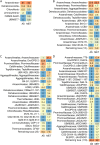Unveiling the hidden diversity and functional role of Chloroflexota in full-scale wastewater treatment plants through genome-centric analyses
- PMID: 39698295
- PMCID: PMC11653643
- DOI: 10.1093/ismeco/ycae050
Unveiling the hidden diversity and functional role of Chloroflexota in full-scale wastewater treatment plants through genome-centric analyses
Abstract
The phylum Chloroflexota has been found to exhibit high abundance in the microbial communities from wastewater treatment plants (WWTPs) in both aerobic and anaerobic systems. However, its metabolic role has not been fully explored due to the lack of cultured isolates. To address this gap, we use publicly available metagenome datasets from both activated sludge (AS) and methanogenic (MET) full-scale wastewater treatment reactors to assembled genomes. Using this strategy, 264 dereplicated, medium- and high-quality metagenome-assembled genomes (MAGs) classified within Chloroflexota were obtained. Taxonomic classification revealed that AS and MET reactors harbored distinct Chloroflexota families. Nonetheless, the majority of the annotated MAGs (166 MAGs with >85% completeness and < 5% contamination) shared most of the metabolic potential features, including the ability to degrade simple sugars and complex polysaccharides, fatty acids and amino acids, as well as perform fermentation of different products. While Chloroflexota MAGs from MET reactors showed the potential for strict fermentation, MAGs from AS harbored the potential for facultatively aerobic metabolism. Metabolic reconstruction of Chloroflexota members from AS unveiled their versatile metabolism and suggested a primary role in hydrolysis, carbon removal and involvement in nitrogen cycling, thus establishing them as fundamental components of the ecosystem. Microbial reference genomes are essential resources for understanding the potential functional role of uncultured organisms in WWTPs. Our study provides a comprehensive genome catalog of Chloroflexota for future analyses aimed at elucidating their role in these ecosystems.
Keywords: Chloroflexota; activated sludge; meta-analysis; metagenome assembled genomes; methanogenic reactors.
© The Author(s) 2024. Published by Oxford University Press on behalf of the International Society for Microbial Ecology.
Conflict of interest statement
The authors declare no conflict of interest.
Figures






Similar articles
-
Unraveling the genetic potential of nitrous oxide reduction in wastewater treatment: insights from metagenome-assembled genomes.Appl Environ Microbiol. 2024 Sep 18;90(9):e0217723. doi: 10.1128/aem.02177-23. Epub 2024 Aug 13. Appl Environ Microbiol. 2024. PMID: 39136491 Free PMC article.
-
Taxonomic Re-Classification and Expansion of the Phylum Chloroflexota Based on over 5000 Genomes and Metagenome-Assembled Genomes.Microorganisms. 2023 Oct 23;11(10):2612. doi: 10.3390/microorganisms11102612. Microorganisms. 2023. PMID: 37894270 Free PMC article.
-
Non-redundant metagenome-assembled genomes of activated sludge reactors at different disturbances and scales.Sci Data. 2024 Aug 9;11(1):855. doi: 10.1038/s41597-024-03601-9. Sci Data. 2024. PMID: 39122705 Free PMC article.
-
A comprehensive overview of the Chloroflexota community in wastewater treatment plants worldwide.mSystems. 2023 Dec 21;8(6):e0066723. doi: 10.1128/msystems.00667-23. Epub 2023 Nov 22. mSystems. 2023. PMID: 37992299 Free PMC article. Review.
-
Upflow anaerobic sludge blanket reactor--a review.Indian J Environ Health. 2001 Apr;43(2):1-82. Indian J Environ Health. 2001. PMID: 12397675 Review.
Cited by
-
Taxonomic and functional partitioning of Chloroflexota populations under ferruginous conditions at and below the sediment-water interface.FEMS Microbiol Ecol. 2024 Nov 23;100(12):fiae140. doi: 10.1093/femsec/fiae140. FEMS Microbiol Ecol. 2024. PMID: 39384533 Free PMC article.
-
Comparative metagenomics on community structure and diversity of rhizomicrobiome associated with monoculture and soybean precedent carrot.Sci Rep. 2025 Aug 1;15(1):28161. doi: 10.1038/s41598-025-13605-z. Sci Rep. 2025. PMID: 40750823 Free PMC article.
-
Isolation of multiple plant growth-promoting fungi and their effect on rice growth improvement on non-grain converted land.Front Plant Sci. 2025 Aug 13;16:1618073. doi: 10.3389/fpls.2025.1618073. eCollection 2025. Front Plant Sci. 2025. PMID: 40880866 Free PMC article.
References
-
- Verstraete W, Morgan-Sagastume F, Aiyuk Set al. . Anaerobic digestion as a core technology in sustainable management of organic matter. Water Sci Technol 2005;52:59–66. 10.2166/wst.2005.0498Available from. https://iwaponline.com/wst/article-pdf/52/1-2/59/433904/59.pdf - DOI - PubMed
-
- Zamri MFMA, Hasmady S, Akhiar Aet al. . A comprehensive review on anaerobic digestion of organic fraction of municipal solid waste. Renew Sust Energ Rev 2021;137:110637. 10.1016/j.rser.2020.110637 - DOI
Associated data
LinkOut - more resources
Full Text Sources
Research Materials
Miscellaneous

